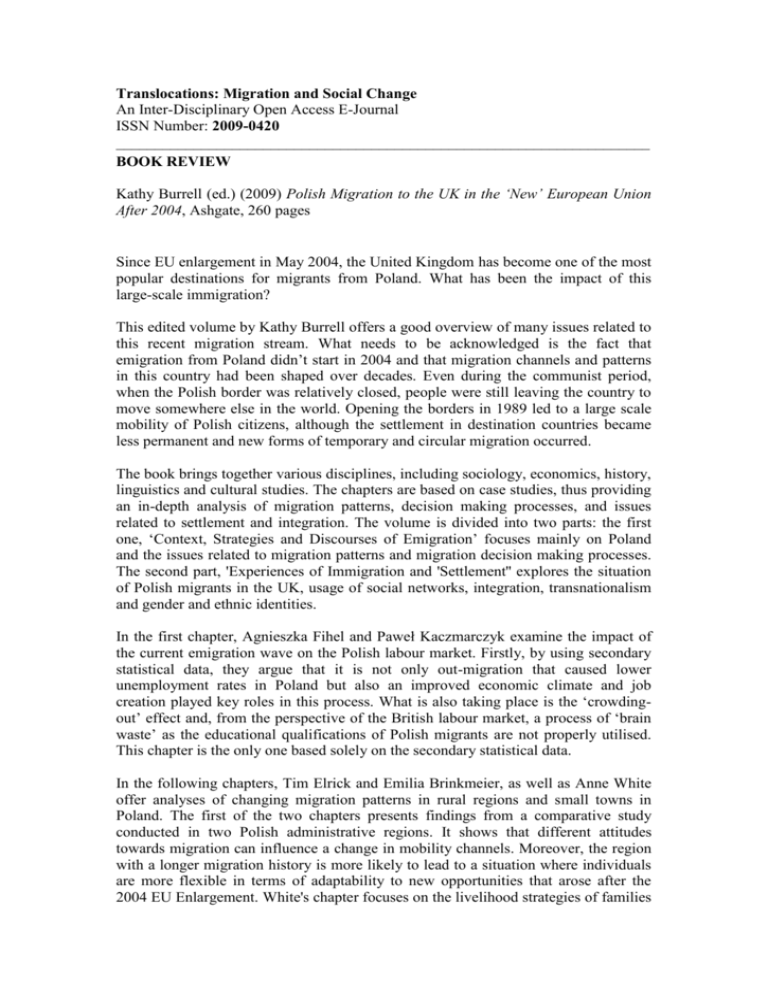Full Text – Word
advertisement

Translocations: Migration and Social Change An Inter-Disciplinary Open Access E-Journal ISSN Number: 2009-0420 _____________________________________________________________________ BOOK REVIEW Kathy Burrell (ed.) (2009) Polish Migration to the UK in the ‘New’ European Union After 2004, Ashgate, 260 pages Since EU enlargement in May 2004, the United Kingdom has become one of the most popular destinations for migrants from Poland. What has been the impact of this large-scale immigration? This edited volume by Kathy Burrell offers a good overview of many issues related to this recent migration stream. What needs to be acknowledged is the fact that emigration from Poland didn’t start in 2004 and that migration channels and patterns in this country had been shaped over decades. Even during the communist period, when the Polish border was relatively closed, people were still leaving the country to move somewhere else in the world. Opening the borders in 1989 led to a large scale mobility of Polish citizens, although the settlement in destination countries became less permanent and new forms of temporary and circular migration occurred. The book brings together various disciplines, including sociology, economics, history, linguistics and cultural studies. The chapters are based on case studies, thus providing an in-depth analysis of migration patterns, decision making processes, and issues related to settlement and integration. The volume is divided into two parts: the first one, ‘Context, Strategies and Discourses of Emigration’ focuses mainly on Poland and the issues related to migration patterns and migration decision making processes. The second part, 'Experiences of Immigration and 'Settlement'' explores the situation of Polish migrants in the UK, usage of social networks, integration, transnationalism and gender and ethnic identities. In the first chapter, Agnieszka Fihel and Paweł Kaczmarczyk examine the impact of the current emigration wave on the Polish labour market. Firstly, by using secondary statistical data, they argue that it is not only out-migration that caused lower unemployment rates in Poland but also an improved economic climate and job creation played key roles in this process. What is also taking place is the ‘crowdingout’ effect and, from the perspective of the British labour market, a process of ‘brain waste’ as the educational qualifications of Polish migrants are not properly utilised. This chapter is the only one based solely on the secondary statistical data. In the following chapters, Tim Elrick and Emilia Brinkmeier, as well as Anne White offer analyses of changing migration patterns in rural regions and small towns in Poland. The first of the two chapters presents findings from a comparative study conducted in two Polish administrative regions. It shows that different attitudes towards migration can influence a change in mobility channels. Moreover, the region with a longer migration history is more likely to lead to a situation where individuals are more flexible in terms of adaptability to new opportunities that arose after the 2004 EU Enlargement. White's chapter focuses on the livelihood strategies of families in small towns in Poland. Through qualitative interviews, she analyses economic and non-economic reasons for family migration and explores a shift from the 1990s norm of sending abroad only one member of the household to new migration phenomena of family reunification in the UK. The chapter by Galasińska and Kozłowska presents an analysis of a ‘normal life’ discourse that can be observed in the interviews and in online forums. As quite often found in migration research, migrants often operate on the basis of a dual frame of reference, comparing work life, working conditions and earnings in Poland and in the UK. It this case the former is often referred to as difficult and the latter as more decent and 'normal'. The final chapter of the first part of the book offers an historical analysis of the image of Polish emigrants in post-war fictional films. As noted by the author, the issue of migration was rarely a theme in Polish cinema until the late 1970s and most of the movies about this issue were produced after the system collapsed in 1989. What is interesting is that films from the post-communist period are not as numerous as one might have expected. What is also intriguing is the fact that most of the movies present migration in quite dark colours with people leaving the country in search of a better future and eventual disappointment abroad. In the second part of the book most contributions focus on the situation of Polish migrants in the UK. Ryan, Sales and Tilki's chapter discusses findings from a qualitative study on migrants' social networks. They found that those Polish migrants with good English language skills extended their networks in the destination country after arrival. On the other hand what can be observed in the case of migrant language skills is the network closure. In relation to integration in the host country, the chapter on Polish migrants in Northern Ireland by Maruška Svašek analyses the outcome of the Shared History Project, which aimed to improve the relations between different ethnic groups in this country. Gender and ethnic identities are the main themes in chapters by Bernadetta Siara and by Ayona Datta. Siara’s analysis focuses on the negotiation of ethnic and gender identities on Polish online discussion boards in the UK. Datta’s chapter explores these issues through visual narratives of Polish construction workers in Britain. In both cases gender identities are strongly linked to different gender roles constructed in Poland. Finally, Rabikowska and Burrell’s chapter explores the role of consumption in the lives of recent Polish migrants in the UK, focusing mostly on food and grocery shops in London and the Midlands. The volume covers a variety of issues related to recent migration from Poland to the UK. Different migrants’ experiences are discussed in this book and different academic perspectives and methodologies have been deployed. The case study focus allows the authors to move beyond the numbers and statistics and to explore this migration process in a more in-depth way. One theme that seems to be missing is a study on Polish professionals in the UK as not all of the migrants are employed below their qualifications. What is clearly shown by this book is the necessity for further research on Polish post-accession migrants. Alicja Bobek Department of Sociology Trinity College Dublin







